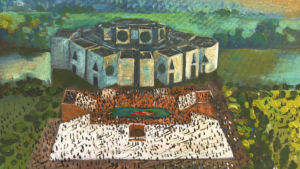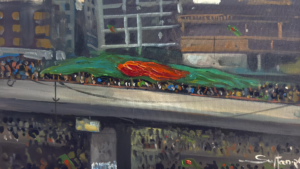
EACH day, Bangladesh records an accelerating number of COVID-19 cases, coupled with harrowing experiences of treatment refusal, job insecurity, eroded income and an overall curtailed control over life. At the strike of the pandemic that necessitates targeted rethinking in budgetary action, it is almost perilous to be on the fence about the significance of redirecting interventions in particular sectors. For the first time in decades, macroeconomic indicators are set to dramatically reverse their course — what had been a gradual decline in poverty since 1992 is about to take off in an upward direction, economic growth is stalled to 5.2 per cent, the lowest since 1980 and unemployment figure almost doubles since 2018, reaching an all-time high since 1984. The revelations, as astounding as they may be, depict a vivid imagery of how ghastly the economic slowdown is becoming and how much of the economic recovery is hanging by a thread by the effectiveness of the point-by-point roadmap to recover lives and livelihoods, laid out by the 49th national budget.
A shortfall in growth components
THE expected growth rate of 8.2 per cent proposed in the budget, reflected by a quick recovery from the current financial year’s 5.2 per cent may be deemed unrealistic. The GDP growth will, in fact, plummet because of added weakening of investment, consumption, government expenditure and net exports, stemming from the pandemic. The share of private investment to the GDP has hovered around 23 per cent for the past few years. The downturn will be swollen by income erosion, diminished savings and, hence, dwindling investment sourced from savings. Earnings from remittances have declined significantly because of COVID-19 as around 300,000 workers returned from abroad. The loss of job and reduction in remittance earnings will dampen consumption spending, in turn, constricting the GDP since private consumption is 70 per cent of the GDP whilst export earnings in April fell by 83 per cent compared with the past year’s figures.
The losses incurred by specific productive sectors shows a 12.4 per cent drop in the overall contribution of the sectors in the GDP. As their total weight in the GDP is 31.44 per cent, a 12.4 per cent drop in their contribution will mean a 3.9 per cent fall in the total GDP. The percentage change between the GDP figures between two financial years shows the expected nominal and real GDP growth rate, 9.4 per cent and 4.4 per cent respectively in the 2019–20 financial year. This is still a moderate estimation, yet lower than what government proposed.
Requirement for well-rounded mid-term framework
FOR a country rampaged by the COVID-19 outbreak, a figure of economic growth may be quite insignificant in comparison. The recovery of the economy, instead, heralds the need for a medium-term macroeconomic framework with particular principles that need to be reflected in the budgetary measures. COVID-19 points out public goods provision failure in health, social security, etc because of underfunding in use value generating public provisioning. The real change in allocation for the health sector from the previous financial year in the proposed budget is 7.8 per cent, which is 5.1 per cent of the budget, but only 0.9 per cent of the GDP. In the proposed budget for the 2020–21 financial year, the allocation for social security is Tk 790 crore higher than the inflation adjusted allocation of the previous year, indicating a real change of 2.5 per cent only and, certainly, it is not ample to secure a decent living for the population that has drowned into poverty, unemployment and income erosion because of the outbreak. Finally, pushing the economy to the next rungs, as the country aspires to be middle-income, requires a transformative production pathway, ensuring a cleaner, greener and stable production system. In order for the transformation to happen, a higher allocation in the manufacturing and the education sector was required. Development budget in the education sector has slightly increased to 19.4 per cent from 18.1 per cent in 2019–20, a proportion as low as 2.7 per cent of the GDP which is not satisfactory at all.
Addressing deterioration in poverty and inequality
THE COVID-19 outbreak has severely impacted the life and livelihood of the marginalised cohorts of societ y— particularly the low-income population, women, children, the elderly, the unemployed, workers in the informal sector, lower-middle class and middle-class groups. Income erosion resulting from losses in various sectors from the shutdown will create a class of new poor. The income erosion will result in 43.5 per cent households having income less than the international poverty line. In the worst-case scenario, with a prolonged shutdown, we estimate 47.43 per cent of the households will have income below the poverty line. A systematic reopening of the economy with a focus on job creation and retention will see the percentage come down to 39.43 per cent. An independent estimation puts the poverty rate at 35 to 40 per cent. Poverty situation may plunge deeper into the valley of uncertainty because of the repatriations of a large number of migrant workers. Almost two million migrant workers are expected to come back home, creating a possibility for an increase in the number of vulnerable families who are solely dependent on their income.
Accordingly, inequality may become more deeply entrenched, with a further differentiated return on labour and capital because of the erosion of income given the preponderance of most of the labour force engaged in the informal sector and the loss of employment in both formal and informal sectors. This would definitely cross the fault line of 0.50 from the existing 0.32 in terms of Gini coefficient while further exacerbating, if measured by Palma ratio of 2.93, as there would be descent of low and middle-income section as new poor. The unsettled issue is that in the case of rising official figures of people living below poverty, which may increase to new heights after the repatriation of more migrant workers, the coverage and scope of social security requires reconsideration. Will the social safety net scheme be able to help the new poor to come out of poverty because of COVID-19? Besides, it is quite uncertain whether the allocation is determined with consideration of the emerging new poor population.
Losses in agriculture and uncertainty of food security
COVID-19 has posited an added challenge to the real sectors that had been vulnerable to collapse far before COVID-19 broke out and require an adequate budgetary allocation for revival of the economy. Although the country demonstrated a steady decline in its severely food-insecure population, the losses incurred by farmers this season may potentially deter production in the next, hinting at a possible food crisis. During the shutdown, the agriculture sector has counted losses of more than Tk 56,000 crore because of unfair pricing and inability to market fresh produce, which is assumed to be tackled through two refinancing schemes of Tk 8,000 crore. Growers of boro rice, the largest cereal crop, keep incurring heavy losses as they are now forced to sell their grains at a lower price than the rate set by the government. Over the past six years, subsidy in agriculture has remained at Tk 9,000 crore, which means that the proportion of subsidy is decreasing every year as the size of the budget increases. In the 2020–21 financial year, the government has increased the subsidy by Tk 500 crore but in the wake of the global pandemic, this increment may not be sufficient to achieve and sustain food security.

Manufacturing losses and tunnel vision prioritising large industries
THE manufacturing sector greatly relies on a single industry and needs diversification and financial assistance to SMEs and women entrepreneurs. Exports are projected to contract by around 18 per cent in the 2020 financial year and a further decline by 1 per cent in the 2021 financial year as demand from major trade partners remains weak. Studies have shown that around 68 per cent of SMEs will exhaust their cash reserves and permanently shut down their businesses if the shutdown persists for more than four months and an aggregate 31 per cent of the enterprises will opt for layoff to minimise costs and keep their businesses afloat. The budgetary allocation is ascertained at Tk 3940 crore, a shocking 0.7 per cent of the GDP, which was Tk 4,101 crore in the 2019–20 financial adjusting for inflation. A reduction in the allocation is preposterous if the manufacturing sector is to be buttressed in combating the COVID-19 outbreak. Women entrepreneurs are supposed to receive at least 15 per cent of all credit within the SME sector. Despite this initiative, most women entrepreneurs are facing difficulties to access credit from banks and other NBFIs. The key barriers are related to collateral requirements and guarantee, trade licence and rigid loan procedures and mentality of bankers towards women entrepreneurs and was not addressed in the budgetary allocation this year.
Losses in transport, tourism and communications
THE service sector generally has the highest budgetary allocation. In the budget for the 2020–21 financial year, the allocation for services sector decreased in terms of public services, transport and communication, defence services than in the budget for the 2019–20 financial year. The COVID-19 situation has more or less halted all the sectors of tourism businesses. Tourism experts assume that if the current situation persists, Bangladesh will have to face an economic loss of more than Tk 3 billion. The transport and communication sectors have suffered massive losses because of COVID-19. The transport sector has lost around Tk 500 crore daily because of the shutdown, according to local estimates. The allocation for the transport sector in this year’s budget, however, is Tk 4742 crore less than that in the previous year. This sector shows a negative real change of -5.5 per cent in budgetary allocation. It may serve to be testing for the government to counter the effects of the global pandemic in this sector with such a reduced budgetary allocation.
Need for apt debt management strategy
The COVID-19 crisis has dealt a massive blow to revenue collection. Revenue collection may face a negative growth of 6 per cent in the 2020–21 financial year because of the economic shutdown. The revenue collected by NBR in the first 10 months of the 2019–20 financial year is Tk 62,000 crore less than the revised target because of the economic halt and loss in real sectors as the impact of the novel coronavirus. Revenue may fall short of Tk 80,500 crore by the end of the 2020 financial year against the revised target of Tk 3,00,500 for the year, implying a deterioration in national debt. The waning revenue has forced the government to resort to heavy borrowing from banks and crowding out private investments and subsequent liquidity crisis. Domestic borrowing from the banking sector has increased to Tk 84,980 crore in the budget proposal for the 2020–21 financial year from Tk 82,421 crore in 2019–20. Unnecessary expenditure takes up a significant proportion of the national budget, a harrowing example of which is the allocation in the public administration sector, which occupies 19.9 per cent of the total budget. Operations budget in this sector has increased to 12.5 per cent in 2020–21 from 9.8 per cent in 2019–20, owed largely to the promotion of personnel to higher levels.
The government needs to reinforce its emphasis on increasing the tax-GDP ratio which now stands below 10 per cent, brought on by a tradition of continued corruption in terms of tax forgery and evasion. Newer avenues of tax revenue should be explored eg taxing undocumented foreign workers in Bangladesh, reducing tax avoidance and re-examining tax exemptions given to politically influential conglomerates. The pressing question is: will tax collection be effective in catering to the emerging new poor population? The government aims at collecting tax revenue of Tk 3,45,000 crore which was Tk 3,13,068 crore in the revised budget. In the proposed budget for 2019-20, tax revenue was projected to be Tk 3,40,100 crore. Unsustainable public debts have a possibility to negatively affect the poverty alleviation and economic growth by repressing the public spending. The economic reality stemmed from COVID-19 unquestionably vindicates an efficient and effective debt management strategy. The optimisation of debt portfolio and revealing the government’s borrowing plan through a proper debt management strategy can significantly result in a positive outcome in the allocation and distribution of budget and help the growth of the capital market.
Broadening lens, focusing on long-term contingencies
APART from an urgent need for formulating a new monetary and fiscal policy framework, the COVID-19 outbreak has reminded humans of the important connotation of balance in nature and a clean environment. It has been also conceived that the recent emergence of epidemics and pandemics is a consequence of constant destruction of nature, biodiversity and its flora, fauna, biotic and abiotic resources. This budget has, however, failed to allot an adequate amount to adapt and mitigate effects of climate change, the pollution of air, water and soil and the destruction of forest land, often exacerbated by the persistent vicious network of clientelist groups hindering the process of green industrialisation.
In the wake of a global pandemic that has overturned the historical legacy of trends in macroeconomic indicators, the budget proposal for the 2020–21 financial year has been endowed with much expectation from the people from all walks of life. It serves as an opportune moment to meet the expectations of people by breaking the shackles of conventional budgetary measures, converging rather on sustainable development as opposed to solely economic growth targets. Ironically enough, the budget still remains abundantly in the spectrum of exclusion and short-sighted motivations and in favour of clientelist networks. COVID-19 has emerged as the harbinger of changes in social, economic and political structures worldwide. In the absence of a radical transformation, the economy is expected to enter a prolonged stalemate and there may be severe blows to social stability.
First Published in New Age





